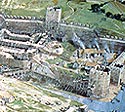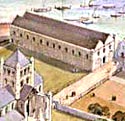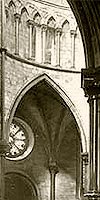![]() London
London

 At
the time of the Norman Conquest London was the wealthiest and most populous
city in England, although still largely confined within walls originally built
by the Romans. London's political role was growing rapidly based on the great
royal establishment at Westminster 1.5km up the Thames from the walled city.
It was here in 1065 that Edward the Confessor was buried in his new abbey church.
At
the time of the Norman Conquest London was the wealthiest and most populous
city in England, although still largely confined within walls originally built
by the Romans. London's political role was growing rapidly based on the great
royal establishment at Westminster 1.5km up the Thames from the walled city.
It was here in 1065 that Edward the Confessor was buried in his new abbey church.
Such was London's importance that William the Conqueror could only feel sure of his position once he had taken London and been crowned at Westminster on Xmas Day 1066. To secure the city he then built two substantial fortifications one at the east (the Tower of London) and one at the west (Baynard's Castle) end of the walled city.
Although London was not described in Domesday Book it is possible to estimate that its population in the late 11th century was over 10,000 a figure which probably doubled by the end of the 12th century. Excavations have revealed a city packed with buildings, mostly of timber, although some of the wealthy had stone houses. Trades and crafts were often confined to certain quarters which is still reflected in London street names like Bread Street and Ironmonger Lane.
 Some
of London's population growth was due to immigration. Merchants from Caen, Rouen
and Cologne settled in London and by 1130 there was a substantial Jewish community.
Growth of foreign trade went hand in hand with the reclamation of the north
bank of the Thames which was consolidated by timber wharves from which jetties
projected. A bridge across the Thames to the growing suburb of Southwark existed
by the early 11th century and was rebuilt in stone in 1176.
Some
of London's population growth was due to immigration. Merchants from Caen, Rouen
and Cologne settled in London and by 1130 there was a substantial Jewish community.
Growth of foreign trade went hand in hand with the reclamation of the north
bank of the Thames which was consolidated by timber wharves from which jetties
projected. A bridge across the Thames to the growing suburb of Southwark existed
by the early 11th century and was rebuilt in stone in 1176.
 The
crown gradually concentrated its functions at Westminster and symbolic of its
status was the construction by William Rufus of Westminster Hall. At the same
time their wealth gave London's citizens the power to secure more and more privileges
of self -government from the king which were enshrined in successive royal charters.
By 1191 Richard I recognised London as an independent commune which after 1215
was ruled by a mayor chosen by the leading citizens.
The
crown gradually concentrated its functions at Westminster and symbolic of its
status was the construction by William Rufus of Westminster Hall. At the same
time their wealth gave London's citizens the power to secure more and more privileges
of self -government from the king which were enshrined in successive royal charters.
By 1191 Richard I recognised London as an independent commune which after 1215
was ruled by a mayor chosen by the leading citizens.
As in other parts of England the cathedral church was
rebuilt; work beginning on St Paul's in 1087. Norman London also saw the foundation
of many new religious houses; the first after the Conquest being Bermondsey
Abbey, followed in the reign of Henry I by three houses of the Augustinians.
Other houses followed including those of the military orders the Hospitallers
and Templars, the church of the latter with its circular nave still survives.
Parish churches numbered over 100.